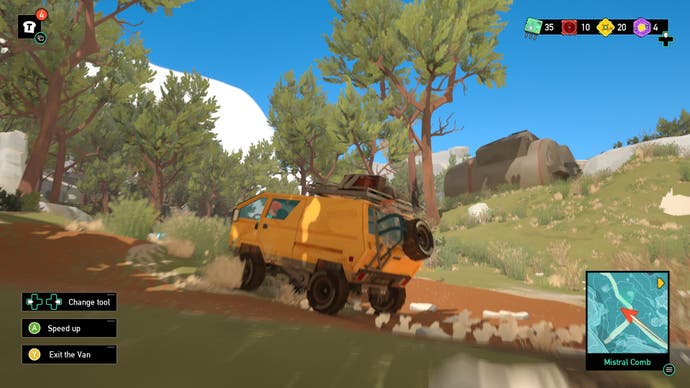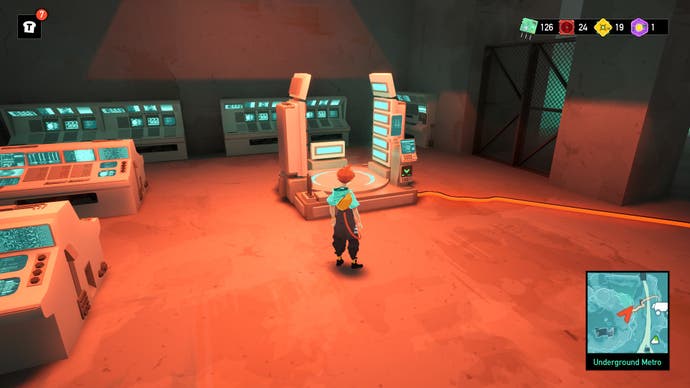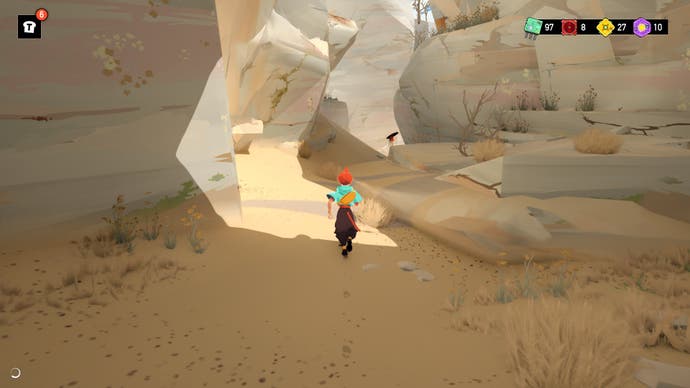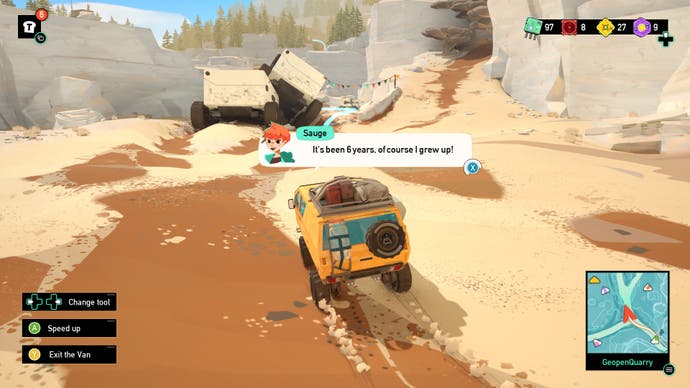Fire up the van and take a dreamy, post-apocalyptic ramble around this gorgeous sci-fi take on Provence.
I spent a good part of this morning trying to remember the precise artwork that Sauge, the heroine of Caravan SandWitch, reminds me of. With her baggy, almost plus four style trousers and bouncing quiff, she’s relatively close to Tintin, but I had a twittering sense that there was something else at play too. Eventually, I remembered it: Emil and the Detectives, the children’s adventure by Erich Kästner. More specifically, those airy, bendy, thick-lined ink illustrations by Walter Trier. Retro and modern all at once, as art struck on the cusp of the 1930s often was. Cheerful and spirited, filled with a headlong sense of derring-do. It’s a perfect fit.
Caravan SandWitch is a lovely thing, an exploration adventure game without player death but brought into focus by a quiet sense of mourning. Sauge has returned to her home planet in search of her sister, who disappeared years ago, but has left a trail of messages behind her. The planet is a beautiful place, but it’s also ravaged, exploited, mined out and now abandoned. The game plays out as Sauge pieces together this mystery of her sister’s life while pelting about the environment in a chunky little van, bringing things back to life, meeting different communities and helping out, and generally being the goodest of eggs. I loved it.
The world is a big part of this. I’ve played a lot of games set on relatively sweet-natured post-apocalyptical planets – most recently something like Creatures of Ava comes to mind. But Ava’s world is inspired by the bioluminescent jungles of Avatar, whereas Caravan SandWitch leans more heavily on a real place, Provence, with its sandy stone, its crags and fields and artful towns. The difference is striking: it feels like this game has much more solid foundations, being based on a proper sense of understanding a place rather than just seeing it on a screen.
There’s variety to the world too. I love the cobbled-together central town, where rough concrete gives way to sun-warmed rock, and where shacks cling to the sides of a canyon wall, but where a bedroom might equally be a space located in some kind of giant outlet pipe. I loved the coast, with its pearly sea froth and spars of rock that could hold secrets. There’s desert and a sort of scrabbly forest too, all of it lying beneath a huge and terrifying wind vortex that sits on the horizon and radiates menace. It’s a compact place, but it has many moods, and it rewards exploring – with trinkets and in-game loot, sure, but also with viewing spots where you can just sit and rest on a blanket or cushion someone’s long since laid out for you , and areas where you can turn on an old radio and hear some weird tinny music for a spell. It’s a game that wants you to linger.
You explore this space in a van that is almost the star of the show, squat and rugged and as joyously utilitarian as a Kanken backpack. The van can be decked out with various gadgets as the game progresses, but it’s also just a pleasure to rattle around in. You can gun the engine for a charmingly unimpressive burst of speed now and then, tackle a jump ramp which sends you about as far into the air as my Chihuahua gets when chasing cats (ie: not very far at all), and speaking of air , fall damage simply does not exist here. Ride the van off a cliff and it’s absolutely fine. Stray too far from it on your adventures and a simple button press will bring you right back to it. charm and convenience: this is almost too much!


Rambling around in the van, the game unfolds as a series of – what exactly? Puzzles is probably too strong a word for the stuff you get up to here. Rather, you take on quests which often lead you out to a series of abandoned installations where there are doors to unlock, grids to repower, cables to trail back to their junction box and a pleasant kind of busywork in place to get everything flowing again. You move through these places, gently opening them up as you search for quest items or the next beat of the story. None of it is particularly taxing, but it’s all quietly delightful. There’s a real sense of exploration here, of being alone but not lonely, of enjoying your own company in a place that has been treated roughly but still contains beauty.
Some of my greatest moments of joy have come from breaking the sequence. In a muddle of main quests and side quests, Caravan SandWitch is not afraid to let you loose in an area you’re not really meant to be in yet, so I often found myself exploring buildings before I had much of a reason to. Far from being frustrating, for me it deepened the wordless mystery at the heart of the game, but also underlined the fiction of being a scavenger in a neglected space, moving between settlers, wanderers, robots, and the planet’s original communities. Lovely stuff.



If there’s a problem here – and it’s only a small one – it’s padding. Caravan SandWitch moves through its narrative as you upgrade those gadgets on your van which effectively open new kinds of doors for you, Metroidvania-style. One gadget might allow you to fire off a line that can be attached to surfaces to wrench them off their moorings. Another might allow you to cross gaps by riding lines that already exist in the world. This is all great, and when coupled with a radar that highlights points of interest as you wander around in your van, it makes for a game rich in distractions. But the price to unlock each new upgrade can feel like a kind of progress tax now and then. I’m tempted to say there might be a really bright, tightly paced four hour game lurking inside this eight hour campaign.
I say that, but since I finished Caravan SandWitch a few days back, more than anything I’ve been eager to go back to it. This gently playful world may actually be at its best when you’re doing not much of anything. Take the van for a coast over the dunes. Pick through a robot graveyard that always looked interesting. Open out the last areas of the map that you’ve already cleared by unjamming radar signals and already picked free of most in-game doodads. There’s a sense of adventure here that runs so deep it must emerge from the land itself.
A review copy of Caravan SandWitch was provided by Dear Villagers.
#Caravan #SandWitch #review #scifi #benefits #power #real #place
